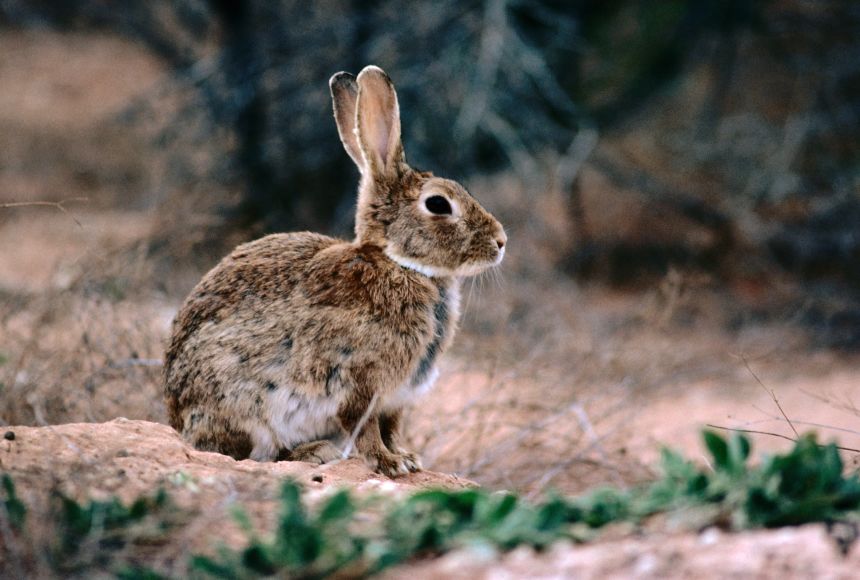Australia has had a problem with European rabbits since their introduction to the continent in the late 19th century. Now, it is estimated that approximately 200 million feral rabbits inhabit Australia.
Introduction of European Rabbits to Australia
In 1859, European rabbits (Oryctolagus cuniculus) were introduced into the Australian wild so that they could be hunted. Thomas Austin, a wealthy settler who lived in Victoria, Australia, had 13 European wild rabbits sent to him from across the world, which he let roam free on his estate. From this one backyard sanctuary, it took only around 50 years for these invasive (meaning non-native to the land) rabbits to spread across the entire continent.
Their numbers became so large that they destroyed crops and land, leading to soil erosion. They also negatively affected agriculture and plants by overgrazing. Not only did the rabbits wreak havoc on Australian croplands, they contributed to the decline of native plant and animal species. Even the Commonwealth Environment Protection and Biodiversity Conservation Act 1999—the Australian government’s main environmental legislation—lists the various effects of feral rabbits, such as land degradation, as a “threatening process.”
These rabbits are extremely adaptive, which has played a role in their spread across the Australian continent. All the rabbits need is soil that is fit to burrow and short grasses to graze on. Since these conditions are fairly easy to come by, they can adapt to new habitats such as the deserts and plains of Australia as easily as the meadows of Europe.
Not only are European rabbits adaptable creatures, they are also known for rapidly producing large quantities of offspring. They can reproduce at a young age, and they can reproduce all year round. European rabbits, or hares, can produce more than four litters each year, with two to five kits (baby rabbits) per litter on average.
Efforts To Deal with Invasive Rabbits
Government researchers, biologists, farmers, and others have all attempted to get rid of Australia’s invasive rabbits. Experts have tried a variety of techniques to manage rabbit populations, including fences, poisons, and pathogens; some have proven more successful than others.
A few decades after the rabbits first arrived in Australia, they became a major problem for farmers. Initially, both farmers and the government built fences to keep the rabbits from destroying their crops. The government even commissioned the construction of a fence that stretched across Western Australia, from the north to the south. However, fencing did little to deter the rabbits. In the case of the Western Australia fence, it merely fenced in rabbits already living in the state.
Farmers have also been known to destroy rabbit warrens (an underground network of tunnels) in an effort to control the population. Destroying the warrens takes away the place where rabbits are able to safely breed and raise young. Today, farmers continue to use the warren destruction method, which is effective for controlling rabbit populations found on accessible lands.
In the 1950s, the government turned to biocontrol. They released rabbits infected with myxoma—a rabbit-specific virus—into southeastern Australia. The myxoma virus was the first ever virus to be purposefully introduced to the wild to eradicate an animal. Australian scientist Peter Kerr said of this release, “Thus, inadvertently, began one of the great experiments in natural selection, conducted on a continental scale.” The myxoma virus leads to myxomatosis, a disease that only kills rabbits. Although the myxoma virus did lead to the deaths of many of the rabbits in Australia, the rabbits eventually developed an immunity to the virus, rendering it ineffective. If the scientists wanted to eradicate these invasive rabbits, they were going to have to try something else.
Rabbit Hemorrhagic Disease Virus (RHDV) is another rabbit-specific pathogen that scientists began to describe in the 1980s. This disease is caused by an RNA (ribonucleic acid) virus transmitted by flies, and it can kill rabbits in 48 hours once contracted. In 1995, this virus escaped a quarantine facility and made its way to the wild. After its official release to control the population in 1996, RHDV lowered rabbit numbers in Australia by up to 90 percent in especially dry areas. Because flies serve as the viral vector, the disease does not affect European rabbits that live in Australian regions that are cooler and receive high amounts of rainfall. As with the myxoma virus, these rabbits have begun to develop resistance to RHDV.
Viruses were not the only population-control measure used on European rabbits; poison proved to be another popular method. One of the main chemicals used to poison rabbits is sodium fluoroacetate, which has a very high mortality rate—more than 90 percent. Carbon monoxide and phosphine are also used to fumigate burrows and kill any rabbits living inside.
Introducing viruses into the wild seems to be the best, most cost-effective way to lower European rabbits’ numbers. Experts are still working to control the numbers of these mammals, so they do not destroy Australia’s habitats. Currently, researchers are studying more deadly strains of RHDV that may be even more effective at preventing the rabbits from overwhelming the Australian environment. Since the European rabbits are an invasive species, and are extremely disruptive to the local environment, finding a solution to rein in and control their populations is imperative.
